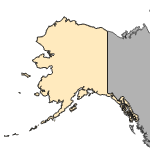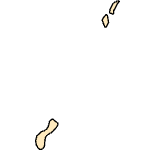Palea steindachneri
(Wattle-necked Softshell)
Reptiles-Turtles
Exotic |
|
Common name: Wattle-necked Softshell
Taxonomy: available through
www.itis.gov
Identification: A large softshell that has a carapace (upper shell) length of up to 426 mm (about 17 in) with wattles (turbercles) on the skin of the neck, especially in a clump where the front of the carapace joins the neck (Pritchard, 1979; Ernst and Barbour, 1989; McKeown, 1996). Juveniles have bright yellow markings, typically a wide stripe, on the sides of the head and neck (Ernst and Barbour, 1989; McKeown, 1996). This arrangement of wattles is not found on Pelodiscus sinensis (Chinese softshell), the only other softshell found in Hawaii (McKeown, 1996). The wattle-necked softshell is illustrated in Smith (1931), Pope (1935), Pritchard (1979), Ernst and Barbour (1989), Zhao and Adler (1993), Ernst et al. (1994), and McKeown (1996).
Size: carapace length of up to 426 mm
Native Range: Southeastern China, including Hainan, and northern Vietnam (Smith, 1931; Pope, 1935; Pritchard, 1979; Ernst and Barbour, 1989; Webb, 1989; Iverson, 1992; Zhao and Adler, 1993).



|

Alaska |

Hawaii |

Puerto Rico &
Virgin Islands |

Guam Saipan |
Hydrologic Unit Codes (HUCs) Explained
Interactive maps: Point Distribution Maps
Nonindigenous Occurrences:
Table 1. States with nonindigenous occurrences, the earliest and latest observations in each state, and the tally and names of HUCs with observations†. Names and dates are hyperlinked to their relevant specimen records. The list of references for all nonindigenous occurrences of Palea steindachneri are found here.
Table last updated 12/19/2025
† Populations may not be currently present.
Means of Introduction: Brought to Hawaii, and probably cultivated, by Asian immigrants as a traditional source of food from the 1800s up till World War II (McKeown and Webb, 1982; McKeown, 1996). The origin of the California specimen is similar, and could have come from an Asian market or restaurant in nearby San Francisco (Van Denburgh, 1917). These turtles also might have been brought to Mauritius for the same reason. The wattle-necked softshell is considered highly palatable in parts of China (Pope, 1935).
Status: Established in Mauritius (Iverson, 1992; Zhao and Adler, 1993). Established in marshes and canals in Kauai and Oahu, Hawaii (McKeown and Webb, 1982; McKeown, 1996). Not established in California (Bury and Luckenbach, 1976).
Impact of Introduction: Unknown; but the potential for this highly carnivorous turtle to have a negative impact on indigenous Hawaiian fauna seems likely, if it has not occurred already. There are no freshwater turtles native to Hawaii (McKeown, 1996).
References: (click for full references)
Bury, R. B., and R. A. Luckenbach. 1976. Introduced amphibians and reptiles in California. Biological Conservation 1976(10):1-14.
Ernst, C. H., and R. W. Barbour. 1989. Turtles of the World. Smithsonian Institution Press, Washington, D.C. and London. 313 pp.
Ernst, C. H., J. E. Lovich, and R. W. Barbour. 1994. Turtles of the United States and Canada. Smithsonian Institution Press, Washington and London. 578 pp.
McKeown, S. 1996. A Field Guide to Reptiles and Amphibians in the Hawaiian Islands. Diamond Head Publishing, Inc., Los Osos, California. 172 pp.
McKeown, S., and R. G. Webb. 1982. Softshell turtles in Hawaii. Journal of Herpetology 16(2):107-111.
Meylan, P. A. 1987. The phylogenetic relationships of soft-shelled turtles (Family Trionychidae). Bulletin of the American Museum of Natural History 186(1):1-101.
Pope, C. H. 1935. The Reptiles of China. Turtles, Crocodilians, Snakes, Lizards. Natural History of Central Asia Vol. X. The American Museum of Natural History, New York. 604 pp. + 27 plates.
Iverson, J. B. 1992. A Revised Checklist with Distribution Maps of the Turtles of the World. John B. Iverson, Richmond, Indiana. 363 pp.
Iverson, J. [B.], P. [A.] Meylan, and M. [E.] Seidel. 2000. Testudines—turtles. Pp. 75-82. In: B. I. Crother (chair), and Committee on Standard English and Scientific Names (editors). Scientific and standard English names of amphibians and reptiles of North America north of Mexico, with comments regarding confidence in our understanding. Society for the Study of Amphibians and Reptiles Herpetological Circular (29):i-iii, 1-82.
Pritchard, P. C. H. 1979. Encyclopedia of Turtles. T.F.H. Publications, Inc., Neptune, New Jersey. 895 pp.
Smith, M. A. 1931. The Fauna of British India, Including Ceylon and Burma. Reptilia and Amphibia. Vol. I.—Loricata, Testudines. Taylor & Francis Ltd., London. 185 pp. + I-II.
Van Denburgh, J. 1917. Concerning the origin of the soft-shelled turtle, Aspidonectes californiana Rivers. Proceedings of the California Academy of Sciences, Fourth Series 7(2):33-35.
Webb, R. G. 1975. Taxonomic status of Aspidonectes californiana Rivers, 1889 (Testudines, Trionychidae). Copeia 1975(4):771-773.
Webb, R. [G.] 1989. Palea steindachneri (Siebenrock 1906). P. 111. In: F. W. King and R. L. Burke (editors). Crocodilian, Tuatara, and Turtle Species of the World. A Taxonomic and Geographic Reference. The Association of Systematics Collections, Washington, DC. 216 pp.
Zhao, Er-mi, and K. Adler. 1993. Herpetology of China. Contributions to Herpetology 10. Society for the Study of Amphibians and Reptiles, Oxford, Ohio. 522 pp.
Author:
Somma, L.A.
Revision Date: 4/1/2025
Citation Information:
Somma, L.A., 2025, Palea steindachneri (Siebenrock, 1906): U.S. Geological Survey, Nonindigenous Aquatic Species Database, Gainesville, FL, https://nas.er.usgs.gov/queries/FactSheet.aspx?SpeciesID=1277, Revision Date: 4/1/2025, Access Date: 12/19/2025
This information is preliminary or provisional and is subject to revision. It is being provided to meet the need for timely best science. The information has not received final approval by the U.S. Geological Survey (USGS) and is provided on the condition that neither the USGS nor the U.S. Government shall be held liable for any damages resulting from the authorized or unauthorized use of the information.